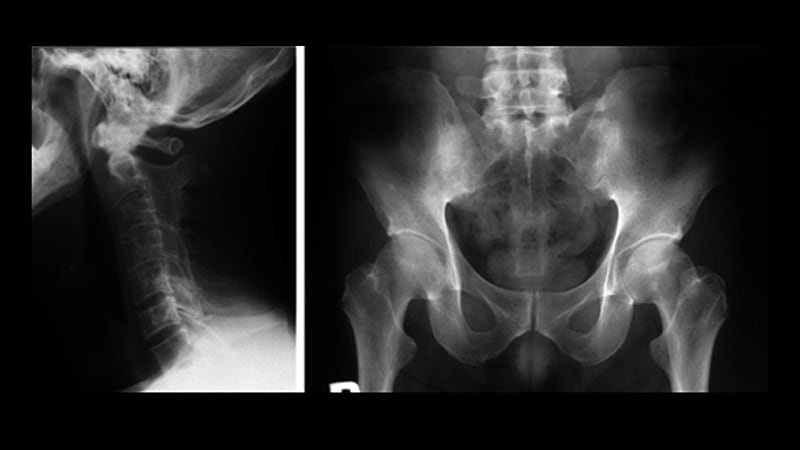NSAIDs Impact MRI Findings in Spondyloarthritis Cases
Core Concepts
NSAIDs can mask inflammation in MRI scans for spondyloarthritis.
Abstract
The study discusses how NSAIDs can affect MRI results in patients with axial spondyloarthritis (axSpA). It highlights the importance of considering the impact of NSAIDs on inflammation levels in the sacroiliac joint (SIJ) when interpreting MRI scans. The DyNAMISM study aimed to evaluate the influence of NSAIDs on MRI results and the implications for diagnosis and treatment decisions in axSpA patients.
Highlights:
NSAIDs may alter MRI results in 1 in 4 axSpA patients.
The study recommends a washout period before MRI scans to avoid masking inflammation.
Uncertainty exists regarding the true anti-inflammatory effects of NSAIDs on axial inflammation.
The study recruited 311 adults with suspected or established axSpA to assess MRI results.
Patients experienced disease flares during the NSAID washout period, but it did not significantly impact disease activity or pain measures.
NSAIDs May Mask MRI Findings in Spondyloarthritis Cases
Stats
"A total of 23% of patients whose MRI results were positive for sacroiliitis when no NSAIDs had been used for a couple of weeks received negative MRI results 6 weeks after the NSAIDs were reinstated."
"The study used a standardized MRI protocol."
"The average age of the study subjects was 42 years, 62% were men, and 87% were White."
Quotes
"NSAIDs are often used as the first-line treatment for axial spondyloarthritis due to their ability to effectively reduce pain and stiffness associated with the condition." - Denis Poddubnyy, MD
"It's a shame you didn't scan the negative people because the natural history is a fluctuating inflammation." - Fraser Birrell, MBChB, PhD
Key Insights Distilled From
by Sara Freeman at www.medscape.com 04-28-2023
https://www.medscape.com/viewarticle/991357
Deeper Inquiries
How do NSAIDs impact the diagnostic accuracy of MRI scans in spondyloarthritis cases?
In spondyloarthritis cases, NSAIDs can impact the diagnostic accuracy of MRI scans by potentially masking the true level of inflammation in the sacroiliac joint (SIJ). The DyNAMISM study revealed that in about 1 in 4 patients, the use of NSAIDs led to negative MRI results for sacroiliitis, even though the scans were positive when NSAIDs were not used. This suggests that NSAIDs may interfere with the detection of inflammation on MRI scans, which is crucial for accurate diagnosis and disease classification in axial spondyloarthritis (axSpA) cases.
What are the ethical considerations when recommending a washout period for NSAIDs before MRI scans?
When recommending a washout period for NSAIDs before MRI scans, several ethical considerations come into play. Firstly, it is essential to ensure that patients are fully informed about the potential risks and benefits of stopping NSAIDs, including the possibility of increased disease activity and pain during the washout period. Patients should be counseled on the temporary nature of these effects and reassured that the majority can tolerate the washout without significant adverse outcomes.
Additionally, healthcare providers must consider the impact of withholding NSAIDs on patients' quality of life and well-being. Ethical guidelines emphasize the importance of balancing the need for accurate diagnostic information with the potential discomfort or worsening of symptoms that patients may experience during the washout period. Shared decision-making between healthcare providers and patients is crucial to ensure that the benefits of obtaining more accurate MRI results outweigh the temporary challenges associated with stopping NSAIDs.
How can future studies address the limitations of the DyNAMISM study to provide more conclusive evidence on the effects of NSAIDs on inflammation in axSpA patients?
Future studies can address the limitations of the DyNAMISM study and provide more conclusive evidence on the effects of NSAIDs on inflammation in axSpA patients by implementing several strategies. Firstly, conducting randomized, controlled trials that compare the outcomes of patients who undergo a washout period for NSAIDs before MRI scans with those who do not can help establish a clearer causal relationship between NSAID use and the masking of inflammation on MRI.
Furthermore, future studies should consider including a larger and more diverse patient population to ensure the generalizability of the findings. By recruiting patients with varying disease durations, severity levels, and demographic characteristics, researchers can obtain a more comprehensive understanding of how NSAIDs impact inflammation detection on MRI scans in axSpA patients.
Moreover, future studies could explore the long-term effects of NSAID use on disease progression and structural changes in the axial skeleton, beyond just the inflammatory aspects. By incorporating comprehensive outcome measures that assess both inflammatory and structural changes, researchers can provide a more holistic view of the impact of NSAIDs on spondyloarthritis patients.
0
